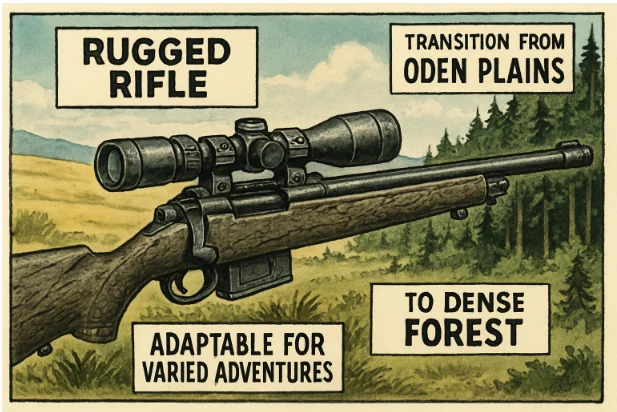Key Takeaways
- Understanding your shooting environment and typical distances is crucial for selecting the appropriate magnification.
- Different reticle types offer various advantages; selecting one that aligns with your shooting style enhances accuracy.
- Durability features, such as waterproofing and shock resistance, are vital for scopes used in diverse outdoor conditions.
Outdoor enthusiasts who explore different terrains understand that precise shooting requires skill, experience, and the right gear. Whether hunting, target shooting, or trekking through unpredictable weather, your optics can determine the success of your outing. Choosing a rifle scope that fits your environment and shooting goals is just as crucial as mastering marksmanship itself. Burris Scout scope Canada provides reliability in demanding conditions.
A proper rifle scope enhances clarity, accuracy, and precision, making a significant difference in shooting performance. The numerous options available can be overwhelming, with factors such as magnification, reticle type, and durability influencing the choice. Shooters need to understand both technical specifications and practical uses, considering features such as eye relief and ruggedness to achieve optimal performance in varying conditions. Investing in a quality scope not only improves accuracy but also enhances the overall shooting experience, allowing more focus on enjoyment rather than equipment reliability. Researching brands, reading expert reviews, and consulting guides are advisable for making an informed selection.
Understanding Magnification Needs
Magnification settings play a central role in achieving pinpoint accuracy during outdoor excursions. Lower magnifications, such as 1-4x or 1- 6x, are ideal for close to mid-range situations—think woodland hunting or shooting at moving targets—where a wider field of view is crucial. These settings are particularly favored by those who need rapid target acquisition and better situational awareness in dense cover. For long-range shooting or open environments, targets may be hundreds of yards away. In these cases, scopes with higher magnification ranges, such as 4-16x or even 6- 24x, allow for precise adjustments, making it easier to place shots accurately at a distance. Choosing magnification must involve a realistic assessment of your most common shooting situations to ensure the scope enhances, rather than complicates, your shot patterns.
Choosing the Right Reticle
The reticle, or crosshair, within your scope impacts both speed and accuracy in target acquisition. There are several types of reticles available:
- Duplex Reticle: A simple, classic design suitable for most hunting and target shooting scenarios.
- Mil-Dot Reticle: Offers built-in reference points for estimating range and bullet drop, advantageous for tactical and long-range shooting.
- Bullet Drop Compensator (BDC) Reticle: Provides quick reference points for adjusting holdover at various distances.
- Illuminated Reticle: Enhances usability in low-light conditions, such as dusk, dawn, or other dark settings.
Matching your reticle to your shooting purpose—be it hunting, tactical drills, or target competitions—adds confidence and precision to every shot.
Durability and Weather Resistance
Adventurers face the elements, so their gear must be up to the task. High-quality scopes are crafted from durable materials, such as aircraft-grade aluminum, and rigorously tested for resistance to shock, water, and fog. Waterproofing is essential in damp environments, while fog-proof construction ensures clarity in humid or cold conditions. A rugged scope not only withstands drops and bumps but also maintains zero in challenging scenarios, making it a wise investment for unpredictable outings.
Considering Eye Relief
Eye relief is pivotal for comfort and safety, especially when firing rifles with substantial recoil. A generous distance between your eye and the ocular lens helps prevent “scope bite” and allows for swift sight alignment, which is vital for follow-up shots. This becomes even more important in dynamic field situations where rapid repositioning is required and shooting stances are less than perfect.
Balancing Budget and Quality
While tempting, cutting corners for the cheapest optics can result in dissatisfaction and even safety issues. Quality rifle scopes feature superior glass, moisture protection, and longer warranties. It’s wise to set your budget realistically, knowing that the benefits of a reliable, long-lasting optic extend to improved accuracy and enjoyment. Reviews from the shooting community can help evaluate the value equation before making a purchase.
Exploring Additional Features
Modern rifle scopes often come equipped with a host of value-adding features. Adjustable objectives enable shooters to fine-tune parallax, resulting in crystal-clear images at various ranges. Fully multi-coated lenses maximize light transmission for sharper vision at dawn or dusk, while features like zero-reset turrets aid in quick re-adjustments after taking a shot. When evaluating options, consider which extras align with your shooting frequency, environment, and skill level.
Final Thoughts
Equipping yourself with the right rifle scope can significantly enhance your proficiency and enjoyment on any outdoor adventure. By factoring in magnification, reticle preferences, weather resistance, and added features, you create a personalized kit that meets the demands of your environment. Balancing budget with quality and leveraging insights from experienced users and trustworthy publications ensures greater accuracy and reliability, shot after shot.



